The Blue Period in the oeuvre of Pablo Picasso is defined as his paintings created in years 1901-1904. It is characterized by obvious domination of various forms of blue colors in paintings. Interestingly, at this point of his life he was definitely feeling blue.
The preceding year before the beginning of the Blue Period appeared to be shocking for the artist. Pablo Picasso’s best friend, Carlos Casagemas, committed a suicide. This event is considered to have led the artist to the period of melancholy and depression (Warncke, 201). Feeling frustrated and left alone, Pablo Picasso tries to express his emotions with the help of canvas and oil. He paints himself and other people with unhappy expressions; emptiness can be read on their faces.
Pablo Picasso’s Blue Period can be defined as the transition of the artist from classical to abstract painting (Getlein,28). While creating the paintings, Pablo Picasso was very young (21-25). Therefore, some drawbacks in composition can be observed at the Blue Period. However, at his time, Pablo Picasso made a real revolution in the world of art with his works. Unusual, serious and grotesque, they form a special class of pictures which introduce the age of modern art.
The Blue Period includes such works as Self portrait, Le gourmet, Blue Nude, La Celestina, Evocation, burial of Casagemas, Casagemas’ Death, Two sisters, the meeting, Life, Old Guitarist, Child with a Dove, Poor people on the seashore, Susanne Bloch, and others.
Child with a dove
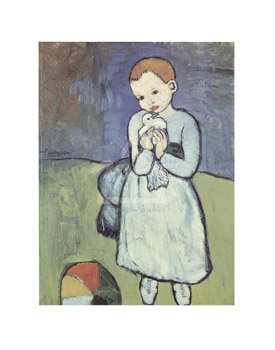
“Child with a dove”, painted in 1901, is the painting which opens the Picasso’s series of the paintings of the Blue Period. Unlike the most of paintings of this period, it is very tender and mild.
A little girl holding a white dove on a playground looks very sad. The picture is still, yet the viewers expect the doe to fly away soon; that is why the subconscious dynamics is present in the work. The light blue and green pastel tones intensify the melancholic mood of the painting. However, the vivid black contours make the figures very contrastive. The brushstrokes can be seen; moreover, it is clear that preceding to the green phone Picasso used deep blue.
Interestingly, starting from this painting the author started to sign his works as simply “Picasso”, with no initials (Raynal, 81). In this painting, the influence of such artists as Gauguin and Cezanne on Picasso’s style of painting can be noticed.
The Absinthe Drinker
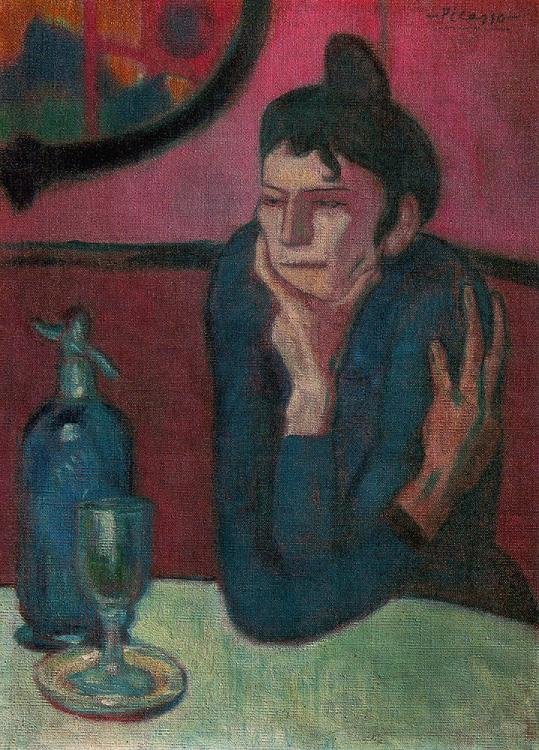
“The absinthe drinker”, created in 1901, is a work which depicts the culture of Paris of that time. Absinthe, at that time a cheap infusion of weeds, was very spread among the youth. A man with a bottle of absinthe was a casual picture of 19th century (Gilot, 241).
The Picasso’s character is very tragic; his posture and expression emphasize his loneliness. He is sitting with his drunken eyes staring in deep thoughts; he is hugging himself with one arm, which is a sign of emptiness, and supporting his chin with another hand. This hand is standing strictly vertical and is situated in the center of the composition, making the painting massive and rude. The palette is comparatively rich; the typical blue colors are combined with red, yet they still are cold. The texture of the painting is homogenious.
The painting is now kept in Russia, at the Hermitage in St. Petersburg.
Self portrait

The picture “Self portrait” was also created in 1901. Painted with oil, this work is very expressive. Pablo Picasso shows himself as a serious figure looking straight into the viewer’s eyes. He is holding his head close to his shoulders, which signals the depressed and insecure state. He is wearing black; the rest of the picture is presented in blue tones.
Despite the motionless figure, the painting looks very expressive because of contrasted colors. The red lips prove the contrast with cold colors and intensify the emotionality of the painting. The contours are highlighted with thick black lines, which make the style similar to that of Picasso (Richardson, 162). The texture is homogeneous; the brushstrokes are slightly noticeable. The work was one of the objects on a famous Spanish exhibition called “From El Grego to Picasso”.
At the moment the painting is exhibited at the Hotel Salé, currently the Musée National Picasso in Paris.
Evocation, burial of Casagemas

After Pablo Picasso’s best friend’s suicide, the artist paints a set of pictures related to his death. One of them is “Evocation, burial of Casagemas”, created in 1901. This work is quite big: its original size is 150.5 x 90.5 cm. It depicts the death of Casagemas in two dimensions: one, people mourning his death on the Earth, and the other, people greeting him in Heaven, where Casagemas arrives on a white horse.
Heaven take 2/3 of the picture and is painted with pale, cold blue and green with bright white stripes symbolizing clouds. These features signify that the artist gets closer to the cubist technique with its vivid forms and bright boundaries. The scene on Earth is painted in warm tones.
The depicted people have no faces, but their postures are extremely expressive; they all show deploration. Noticeably, the Earth part is still, while the heaven part is very dynamic. What is more, the colors used are also very dynamic. In fact, the colors are “dirty”, which gives the feeling of massiveness. This painting greatly demonstrates how good Picasso was at organizing the composition with many people in a way that looks natural.
Casagemas’ Death
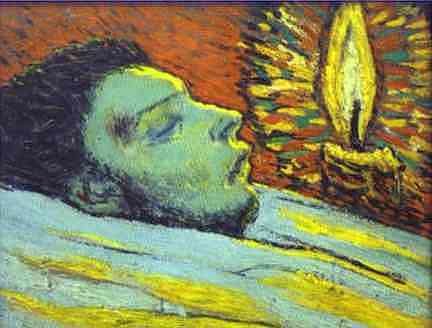
One of the most striking works of Picasso’s Blue Period is “Casagemas’ Death”. As it is known, Picasso’s best friend committed a suicide in a temple (Leal, 159). This fact could serve as a reason why the central object of the painting is a bright light of a candle.
The rays of the candle enlighten the face of Casagemas. The cold colors of the dead body are contrasted with the hot light – a comparison of death and life. The still body is combined with the dynamic flame. The candle is the only vertical line on the painting, which makes it look like an axis of the picture.
The grotesque brushstrokes make the painting even more convincing. The zoomed scale makes an impression of the real presence near the object; in addition, the falling horizon adds the pessimism to the already tragic plot. The texture is grained; the artist used a thick layer of the paint.
All in all, the painting is very tragic and expressive.
The painting is now kept in France, at the Musée Picasso in Paris.
Le gourmet

The name of this picture, “Le gourmet”, is often translated as “The Greedy Child”. However, if translated from French this word actually means “gastronome”. Picasso shows a boy eating at a table. The dynamical character of the boy is supported by mosaic surrounding; however, even despite making some moves he stays motionless. In comparison with other works of the Blue Period, this work can be defined as the most aristocratic one.
In contrast to death, prostitutes and alcoholics Picasso depicts a boy with perfect hair and manners (Cowling, 319). Furthermore, the boy’s figure is shown as small with the help of surrounding objects, which are big; even the plate is too wide for the boy’s hands. This can be a sign of the character’s loneliness. The colors are pale blue, as in most of the pictures of the period; the warm stains are also present.
This picture differs from others by the technique of painting: the brushstrokes are very shallow and vivid. This technique gives an impression of a crayon-painted picture. This picture also contains more details than others; therefore, the elements of classicism are obvious.
At the moment the painting is together with some of the works of Picasso’s Blue Period in USA, at the National Gallery of Art in Washington.
Blue Nude

The picture “Blue Nude” was painted in 1902. It depicts a necked woman crying sitting with her back to the viewers. Her body and the background are painted identically; only the thick black lines show her shape. The author also uses pink tones in order to contrast between the body and the surrounding. In this picture Pablo Picasso tries to make the first steps to primitivism, showing the simplified shapes (Franck, 143).
The colors are not presented separately; all the tones seem to be flowing out from each other. The setting is unclear, as the painted woman has no ground under her; however, she does not look like hanging in the air: her posture is obviously fixed. All in all, despite the vivid lines, the picture looks very integral.
La Celestina
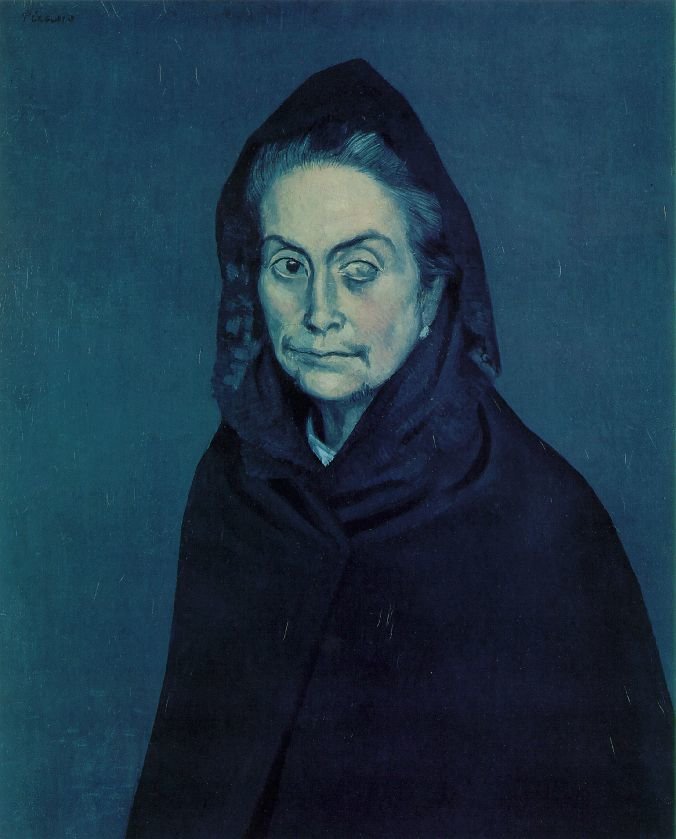
“La celestina” was painted in 1903. On the picture there is a woman with slightly grayed hair. The composition is still. She sits in a posture, traditional for Picasso’s portraits: with her body turned 30% to the West and her head turned full face to the viewer. The woman is dressed strictly: she has a black headscarf on.
However, her facial expression shows some foxy thoughts. Her eyes, one of which is blind, are staring right, her eyebrows slightly raised, and her lips mysteriously simpering. Thus, Picasso reveals the character of the woman: both the model and Celestina were procuresses (Jaffe, 82). The dark tones are presented by homogeneous style of painting. The absence of the setting emphasizes the importance and expressiveness of the character.
The painting is now kept together with the author’s self-portrait of the Blue Period, in Paris, the Musée National Picasso.
Two sisters, the meeting

The picture “Two sisters, the meeting”, created in 1902 depicts two unhappy women standing together. The painter was inspired for this work by his visit to the Paris prison of St. Lazare. The interesting detail about that prison was that it was guarded by nuns. Therefore, the women on the picture are probably nuns or a nun and a prisoner (Gilot, 328).
The both characters are still. This work shows Pablo Picasso’s cubist preferences. The work is very contrastive, the semi-shadows are often omitted, the shapes are clean-cut. Some state that the simplified shapes, especially the way of painting the faces, points to the Christian motives (Warncke, 134).
The tones vary from light blue to dark violet. The typical distinct counters are less noticeable than in other works of the period. The curl of the arch on the left repeats the form of the sisters’ heads bend to each other, and the shadow on the right continues this pattern. The barefooted women with their heads covered remind the Discalced Carmelite Nuns.
Nowadays the painting is in Russia; specifically, in the Hermitage, St. Petersburg.
The old guitarist

“The old guitarist”, created in 1903, is one of the “mildest” works of Pablo Picasso’s Blue Period referring to the technique. A homeless man, probably drunk, playing his guitar is shown in the picture. The simple forms are yet detailed; the muscles and tendons are clear. The typical pale blue tones are combined with a warm stain (guitar) and bright white strokes, just like in most of the described paintings.
The composition is still; only the guitarist’s hands are supposed to express dynamics, but in fact they are also relaxed. The three horizontal lines (the man’s head, hand and legs) are connected by the vertical one (the guitar).
At the moment the work is situated at the Art Institute of Chicago in USA.
Life

The painting “Life” is another work where Picasso originally situates many figures. The author depicts Casagemas with his lover, and a mother with a child near them. The picture also refers to the set of Casagemas’ portraits.
The triple dimension includes the three front characters, one person at the background and also two people painted on a picture behind the front characters. All the figures are motionless; only the couple on the left compensates the still composition. None of the characters meet with their eyes; this also adds some dynamics to the painting. The colors change from light blue on the top to brownish green on the bottom.
The bright white stains highlight the front space and serve as a frame for the background. In this picture, author uses as much contrast as it was possible. One of the most obvious is the contrast between the necked couple and a woman in the fabric.
Interestingly, the painting shows the alive friend of the author, surrounded by the closest people, which shows the deep feeling of respect that Picasso had to Casagemas.
At the moment the work is in USA, The Cleveland Museum of Art.
Poor people on the seashore
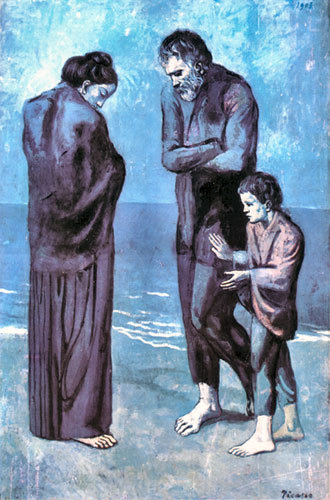
The painting “Poor people on the seashore” depicts a family of three, a mother, a father and a son. Another name for the painting is “The tragedy”. The painting refers to the period when Picasso was concentrated on the general message more than on composition. Thus, the composition is rather inconsistent: the woman is still, but the man with the boy is moving in some direction; but their route seems to include hitting the woman.
The characters are painted with violet; for the background Picasso used pure light blue colors. They express the frozen sea and the winter sky; the people with no shoes on also show that they are cold. In general, the mood of the painting is expressed very clearly. The pale stains in this painting are not only used in some elements, but also for underlying the contrast with dark tones.
All in all, despite the imperfect composition, Picasso managed to express the atmosphere excellently.
The painting is now at the National Gallery of Art in Washington, USA.
Suzanne Bloch
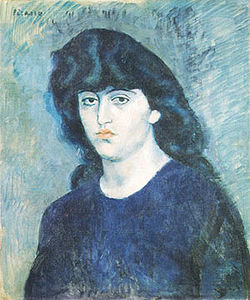
“Suzanne Bloch” is the last painting from Pablo Picasso’s Blue Period. This portrait does not differ much from the other portraits of Picasso: the typical composition, model’s posture, tones and style of painting.
A still woman looks straight into the viewers’ eyes; the dark tones of clothing and hair are contrasted with very pale skin. Warm orange lips also prove a contrast to the general cold of the painting. The texture is rather coarse, which makes the painting look messy. The portrait also has an interesting story. It was once stolen from a museum and found a year later, undamaged and safe (Leal, 287).
All in all, the Blue Period in the artistic work of Pablo Picasso is one of the most prolific ones. The feeling of resignation was one of the strongest stimuli for the artist to create his works. The Blue Period is marked by expressive melancholic paintings and a palette of cold blue colors. Because of the mournful mood, author depicts unhappy people.
None of the characters painted during the Blue Period is smiling; they all embody either poor, sad or stereotypically bad characters. In addition, the style of Picasso’s paintings becomes very recognizable; it still contains the aristocratic tones and mild transitions but at the same time has the roots of cubism. The main features of the Blue Period’s portraits are stillness, heavy dark colors, and thick black contours. Nowadays the works are kept in greatest galleries of the world and admitted to be ones of the world best works.
Works Cited
Barnet, S. A short guide to write about art 9th edition. London: Longman, 2002. Print.
Cowling, E. Picasso: Style and Meaning. Phaidon Press, 2002. Print.
Franck, D. Bohemian Paris: Picasso, Modigliani, Matisse, and the Birth of Modern Art. Grove Press, 2003. Print.
Getlein, M. Living with Art 8th Edition. McGraw Hill Higher Education, 2007. Print.
Gilot, F, Lake, C. Life with Picasso. Virago,1990. Print.
Jaffe, H. Picasso (Masters of Art) New York: Harry N. Abrams, 1983. Print.
Leal, B. The Ultimate Picasso. New York: Harry N. Abrams, 2000. Print.
Raynal, M. Picasso: Biographical and Critical Studies. Skira,1959. Print.
Richardson, J. A Life of Picasso: The Prodigy, 1881-1906. Alfred A. Knopf, 2007. Print.
Warncke, C, Walther, I, Taschen,G. Picasso Taschen: illustrated edition, 2003. Print.